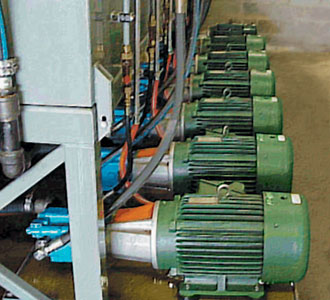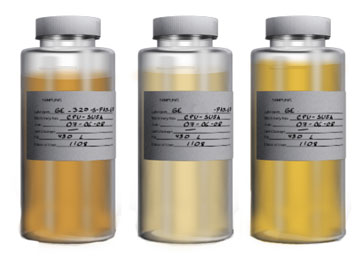Lube Tips
Advice for Greasing Motor Bearings
 When applying grease to an electric motor bearing with a grease gun, use caution and pace yourself. Take 3 to 5 seconds per shot from the grease gun and give the grease time to distribute. If grease appears around the shaft or out the purge line, stop adding grease immediately; the cavity is full. After adding the appropriate amount of fresh grease (maximum volume), leave out the purge plug for 10 to 30 minutes to allow excess grease to purge. Do not worry if grease doesn’t purge because this is common. Reinstall the plug in the purge port (or pipe).
When applying grease to an electric motor bearing with a grease gun, use caution and pace yourself. Take 3 to 5 seconds per shot from the grease gun and give the grease time to distribute. If grease appears around the shaft or out the purge line, stop adding grease immediately; the cavity is full. After adding the appropriate amount of fresh grease (maximum volume), leave out the purge plug for 10 to 30 minutes to allow excess grease to purge. Do not worry if grease doesn’t purge because this is common. Reinstall the plug in the purge port (or pipe).
How to Improve Coupler Reliability
To improve the reliability of grease-lubricated couplings, use only greases formulated for this purpose. General-purpose greases often have thickeners that are heavier than the oil. When subjected to the continuous and extreme forces of a spinning coupling, the thickeners in general-purpose greases can centrifuge to the outside, leaving the oil on the inside. Unfortunately, the outside is where the oil is needed. With regards to weight, the thickeners in coupling greases are equal in weight or lighter than the oil, ensuring that the wearing parts in the coupling are well-lubricated.
A Better Way to Get Water Out of Oil
 A water leak caused the contamination of 150 gallons of lube oil in a sump. The water was removed from the lube unit using a shop vac. The oil normally runs at 120 degrees F and evaporates the water from the oil, which condensates on the inside lid of the tank and drips back into the oil. Attaching the vacuum to the fi ll port and pulling air into the tank through a desiccant breather removed the condensation. In 36 hours, the oil tested dry. Further analysis showed no damage to the oil or additives. Not only was the unit kept running, but 150 gallons of oil were saved.
A water leak caused the contamination of 150 gallons of lube oil in a sump. The water was removed from the lube unit using a shop vac. The oil normally runs at 120 degrees F and evaporates the water from the oil, which condensates on the inside lid of the tank and drips back into the oil. Attaching the vacuum to the fi ll port and pulling air into the tank through a desiccant breather removed the condensation. In 36 hours, the oil tested dry. Further analysis showed no damage to the oil or additives. Not only was the unit kept running, but 150 gallons of oil were saved.
Track Contamination Control Efforts
Are you measuring the results of implementing best practices for contamination control? Sometimes when best practices are implemented for contamination control (filtering top-off oil, installation of desiccant breathers, repairing oil leaks, etc.), the results of your efforts are difficult to quantify. Try using this method as a starting point: Take the last six results of oil analysis on the 10 most critical hydraulic systems in your facility. Look at the ISO cleanliness codes and decide which particle sizes (4, 6 or 14 microns) are the most important to exclude in these systems. In a spreadsheet, track the range of that particle size only and average all 10 to get a baseline number. Improvements in your systems will be evident as future samples are taken and the results averaged. Set a realistic goal of perhaps reducing the average range number by one whole cleanliness code. Post the results so others may see the subtle but important improvements of particle exclusion.
Use Paint to Help Detect Oil Leaks
Consider painting your equipment white. Oil leaks will be more noticeable, and even your most junior operator knows oil or grease on white equipment is not normal.
Field Test for Monitoring Lubricants
When changing oil or lubricants in large equipment that has a long runtime between changes, retain a small sample in a clear container to have for baseline comparisons. A color change may not be noticeable unless a side-by-side comparison can be made. Also, there may be slight changes from batch to batch or from different suppliers.
Lube Tips
The “Lube Tips” section of Machinery Lubrication magazine features innovative ideas submitted by our readers. Additional tips can be found in our Lube-Tips email newsletter. If you have a tip to share, email it to us at editor@noria.com.
